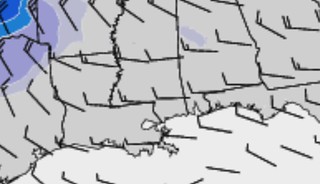The next system isn’t set to swing through at a typical angle, and that means the severe weather threat continues to diminish – though it won’t be zero. The area may see a few storms Saturday afternoon and evening. Most of these will be regular storms. Some may be on the strong side. But the threat for severe weather doesn’t really arrive until Sunday morning.

Notice that the overall threat for the area has diminished. Let’s take a look at the timeline and why we are – in general – less concerned.
Timeline in a Nutshell…

Saturday afternoon: Passing clouds, hit and miss showers and storms. Severe weather not anticipated at this point. A strong storm is possible with heavy rain, frequent lightning, gusty wind and small hail. Temperatures around 75.
Saturday evening: A lull in the action for some of the area. Showers and storms become fewer and farther-between. Temperatures falling back into the 60s.
Saturday night late / Early Sunday morning: Isolated supercell thunderstorms possible ahead of the line of strong-to-severe storms. The main concerns are heavy rain, frequent lightning, damaging wind gusts, hail up to the size of quarters, and the possibility of a brief, weak tornado.
Sunday morning: Line of storms falls apart as it passes through. This will have heavy rain, frequent lightning, gusty wind, and the possibility of small hail. A tornado can’t be ruled out, but it isn’t a main concern.
The Sciency Breakdown
First things, first! Notice all of the storms in the map above off the coast and into the Gulf of Mexico? That is playing “wrecker” with our severe weather chances. It is doing a good job at dwindling our threat alone.
But there is other stuff, too.
As the system swings this direction, it isn’t coming from the usual direction. And is off by about 500 miles. That means the atmosphere isn’t going to be oriented in an “A-Typical” way – and that should be good news for us.

Generally, when we get areas of low pressure that pass by between (roughly) Oklahoma City and Nashville, the area of low pressure is moving from west to east (with maybe a bit of a northeasterly kick to it). That means the cold front that passes by sets storms up to travel in the “A-Typical” southwest to northeast direction along the cold front. And even though the cold front may be moving from west-to-east, because it is oriented from southwest-to-northeast, storms within the line, tend to move from southwest-to-northeast, too.
In this situation, the area of low pressure is diving southeast. Take a look at the GIF of 500mb vorticity. The area of red moving from Nebraska to Tennessee is the area of low pressure that is eventually going to affect our weather.
Notice that it is – definitely – not moving west to east. Because of that, as well as a host of other factors, the associated cold front we expect to push through the area is going to be aligned more west-to-east, moving south. And not oriented southwest-to-northeast moving west. So when storms move along the cold front they will be moving west-to-east.
We can then jump in and take a look at estimated storm motion from the model guidance to see if that lines up with our thinking.
And it does!

This time, storm motion may actually be a lot like the last storm system: west to east. or even west-northwest to east-southeast. This would decrease the tornado threat and increase the hail and wind threat.
Why does that matter?
While the line of thunderstorms may bring with it heavy rain and gusty wind, often meteorologists are more concerned about the Supercell Thunderstorms – either on their own (called “discrete” storms) or embedded (hidden) within the line.
Supercell thunderstorms are the most prolific severe weather producer. The storms use a conveyor belt within them. They need warm air to come in from the south to feed it, it gets pulled up into the storm and then cooled, and dropped on the north side of the storm. And when they travel from SW to NE, you can think of it like Pac-Man chomping up all the warm air ahead of him.
And, if I can continue with this analogy, if Pac-Man is facing a different direction than he is traveling, it is tough for him to chomp down food, right?
That is what happens to supercells when they start moving a different direction than SW to NE. It becomes more difficult (though not impossible) for the storms to have easy access to warm moist air. And the conveyor belt has a more difficult time becoming established.
This means that while storms will still pack a punch, and will still have the chance to be severe… But it may be a bit more difficult for strong tornadoes to develop.

The CIPS Analogs highlights this pretty well. It shows that while looking at the Top 15 most similar situations, there is – historically – a tornado less than 10-percent of the time. And there were only two of the Top 15 that produced tornadoes here.
Bottom Line
Be prepared for some severe weather overnight Saturday and into Sunday morning. The main threat will be rain and wind. But we can’t rule out the possibility of a tornado. This isn’t a widespread severe weather outbreak. There may only be a few storms that are severe. So, as it looks like right now, there isn’t any reason to lose sleep over this threat.
Reminder!
You can always get the latest forecast discussion from the National Weather Service here. You can always get the latest information on the severe weather threat here.

